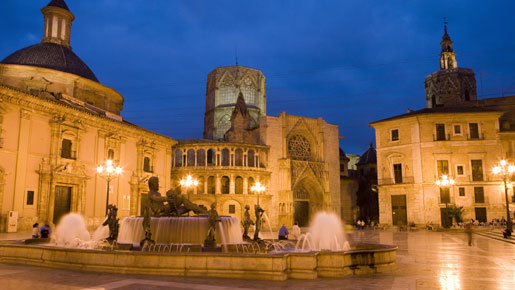
Often described as ‘the new Barcelona,’ Valencia, Spain’s third largest city, has a very distinct character of its own. A rich, elegant city, bankrolled by fruit and food, its charm lies in its mix of beautiful and imaginative architecture, easy-going café culture and famously lively nightlife.
For centuries, the old city of Valencia sat in a bend of the snaking River Turia, but when that river flooded disastrously in 1957, its course was diverted and now it is spacious parks and gardens that flow for 14km around its centre.
Within its arms lie medieval churches, baroque mansions, palm treelined boulevards, some seriously good shopping, and a host of excellent museums. See great Spanish paintings by the likes of Goya, Velasquez and El Greco at the Museum of Fine Arts and superb ceramics in the spectacular Palacio de Dos Aguas. In the must-see Llonja, where silk merchants once traded, slender, twisting stone columns fan out like palm trees into ribbed vaults. The whole 15th-century building is a fine monument to the stonemasons’ art.
In a flurry of Modernista, Spain’s answer to Art Nouveau flowers at the castle-like railway station, makes the domed Post Office into a star attraction, decorates two terrific markets, as well as catching the eye in apartment blocks around the city. And the futuristic buildings of the City of Arts and Sciences are pure 21st century design, exciting inside and out.
On the Costa del Azahar, coast of the orange blossoms, Valencia has an undoubted zest for life. Famously nocturnal, Valencianos know how to party, and their city is famed for its cutting edge clubbing scene and crazy fiestas. The craziest of them all, Las Fallas, happens in March.
Although the festival lasts for a boisterous three weeks of music and processions, the key events happen between March 15 and 19. That’s when the gigantic satirical fallas sculptures, parodying Spanish and world politicians and events, appear in the streets, firecrackers deafen during the day and fireworks pattern the night; the Ofrenda Virgen ceremony sees children in traditional dress strew millions of petals around a towering, flower-packed statue of the Virgin Mary outside the Cathedral; and the papier-maché sculptures, which have taken a year to prepare, are filled with fireworks to end their short lives in a ritual burning ceremony that lights the sky for miles around.
Revellers are sustained by creamy hot chocolate and sugar-dusted doughnut-like churros – and the bars and restaurants of the fashionable Barrio del Carmen. Valencia is the place to eat paella, which originated in the orange groves around town.
For the first time in its long history, the America’s Cup, sailing’s most high-profile yacht race, is being contested in Europe, and Valencia is the host city. With the new Port America’s Cup development, part of its gritty commercial port has been turned into a massive marina for the super-yachts, their teams, and an entertainments centre with everything from cafés to nightclubs for the public. The regatta season will last from April to July.
Between Las Fallas and the sailing events, there are the colourful processions of Semana Santa in the lead-up to Easter. In Valencia, there’s always something going on, and always a reason to party.
178 Astoria Palace, Plaza Rodrigo Botet 5, 46002 Valencia, tel: +34 963 98 10 00, www.hotel-astoria-palace.com
The prestigious 4-star Astoria Palace, in the city centre, has an executive club floor and great views from the terrace of the smart 10th-floor Vinatea restaurant.
Ad Hoc Monumental, Calle Boix 4, 46003 Valencia, tel: +34 963 91 91 40, www.adhochoteles.com
With exposed old brick walls and wood-beamed ceilings, a neat 28- roomed hideaway in the city’s historical quarter.

